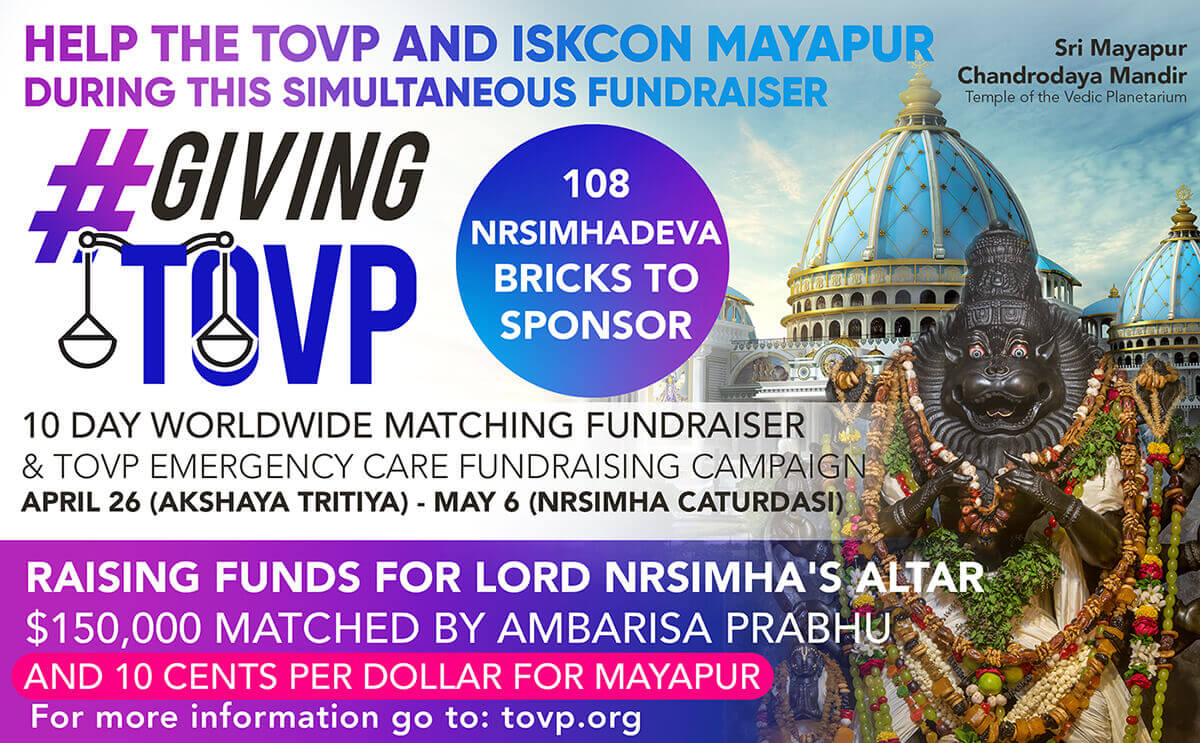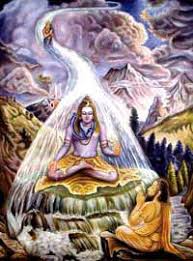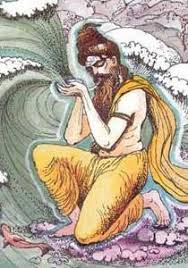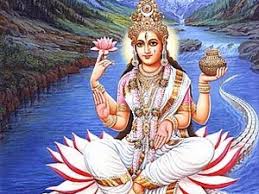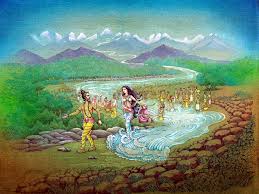 The Passing of Arca Vigraha Devi Dasi
The Passing of Arca Vigraha Devi Dasi
by Daivi Sakti Devi Dasi
Arca Vigraha Devi Dasi joined ISKCON in 1985. She was a successful artist who was disillusioned with material life and wanted an alternative. For a long time she searched for the truth, and she was finally satisfied when she met Srila Prabhupada’s devotees in South Africa.
She discussed philosophy with them and considered how to dovetail her art career in Krishna’s service. Thus she began working on a series of charcoal drawings which included passages from Srimad-Bhagavatam and the Bhagavad-gita depicting the qualities and activities of Kali-yuga. She graphically portrayed the ills of deviating from the four regulative principles to show the truth about Kali-yuga.
Then one devotee returning from Vrindavan showed her some exquisite photographs of all the holy places. She fell in love with Vrindavan and during Kartik of 1986 made her first visit, which left an indelible impression on her mind.
Owing to her artistic talent, she was always requested to paint deities, but she was not allowed to until she received initiation from His Holiness Giriraj Maharaja in 1987. He named her Arca Vigraha Devi Dasi, indicating she was the servant of the deity form of the Lord. She was deeply thrilled upon receiving second initiation, as now she could paint installed deities. This gave great meaning to her life, and soon she painted all the major deities in South Africa and Mauritius. When she returned to Vrindavan, she was asked to paint the deities there, including Srila Prabhupada in his samadhi.
Six months after initiation, she learned she had cancer. She underwent an operation, took radiation treatment, and got some temporary relief. She then bought a piece of land in Raman Reti near the temple, where she intended to build a house for her spiritual master. She began to travel back and forth between South Africa and Vrindavan, bringing earnings from art sales to build the house. During this time she performed a variety of services, though her health deteriorated.
In 1991, on the appearance day of Lord Nrsimhadeva, she realized the cancer had returned—this time in her lymph gland. When she told her spiritual master, he advised her, “Sell up everything. Just run to Vrindavan and let Srimati Radharani take over.” She then returned here with her godsister Kuntidevi to assist her.
Her guru maharaja told her to increase bhajana and japa, to read as much as possible, and to serve in the holy dhama. She did that and continued painting, but as time went on, the cancer in her shoulder and neck began to impair her movements. That spring she was confined to bed; thus she could no longer attend the temple program. So she increased hearing and reading about Krishna’s pastimes, which became more and more enthralling.
Whenever she got a burst of energy, she would sit up in bed and work on designs for two carved marble panels in Srila Prabhupada’s samadhi. Meditating on Srila Prabhupada made her closer to him than ever before. She found great solace in hearing about his final years and how he had served right up to the last moment.
While Arca Vigraha prepared to leave her body in the association of devotees in Vrindavan, we asked her to share her realizations with us.
How do you overcome the extreme pain?
What helps me transcend the pain is kirtan. B. B. Govinda Maharaja does kirtan here. He sings to me, and I become extremely blissful. I can transcend the pain when I’m hearing that. Other devotees also do bhajana here, and of course the readings of various literatures is really helpful.
I remember all the love and help I’ve received from the devotees. It’s as though they’ve taken me step-by-step out of this material world. I’m eternally indebted to them for all the support they’ve given me. I have never known such selfless love as this. My impending death has forced all of us to look into ourselves and become more selfless. Srila Prabhupada said, “Don’t think this is not going to happen to you.” We all know that finally we’ll have to go through this. I just happen to be the first in line right now. It is tolerable because we know where we are going.
What realizations are you getting about where you are going? Any glimpse from the saintly persons who come to see you?
Yes. I have a glimpse from them. I meditate on what they tell me, and it sounds very encouraging. I won’t take birth in the material world again. But I really accept whatever Krishna wants me to do as long as I can serve Him and Srimati Radharani. That’s really all that I would like. I know I won’t go through this again. All I want to do is to serve in a healthy body again.
Are you able to maintain your chanting?
Yes, I can chant, but it takes a bit longer and I can’t always do so aloud. I have to whisper, but I’m able to do it. I chant sixteen rounds a day and more when I can. But I don’t count any more. It’s tiring to count it now.
You’re hearing and preparing to go back to Godhead like Maharaja Pariksit did. What is the message you have for other devotees who will be in your position later?
One big realization is the importance of remembering the name of Krishna. We have always been told to remember Krishna and never forget Him. With everything that happens to us in this situation, Krishna is saying, “Drop this attachment. Clean up all attachments and desires and remember Me only.”
All mortal beings will either leave us or die. It’s only Krishna who will never let us down. He is the only one we can rely on. The more suffering you go through, the more you realize it. We have to be completely pure to serve Him, and that’s what He wants. I don’t resent what I’m going through. Hearing Krishna’s pastimes is endearing Him to me much more. He’s so charming that I just want to serve Him.
Anyone who finds himself in this position must take great courage. Only this philosophy will answer the questions of life. We are so fortunate to know where we are going. Whatever Krishna is arranging for you, just have great faith. Hear His pastimes, for that will make you appreciate. It will give you a little glimpse, a little taste of the love we should develop for Him. Never let that faith go or you’ll become despondent, you’ll get depressed.
Devotees’ association is the best thing at a time like this. I couldn’t do without it. I’m getting a lot of mercy, and I hope I will not let them down.
Is there a particular example in Srimad-Bhagavatam that encourages you?
Grandfather Bhismadeva and how he left his body on the bed of arrows. A devotee can either laugh or cry about death. If you lament, then somehow you’ll have to keep going through the same test until you give up the lamentation.
But if you can see the beneficial side of it, you can mine every jewel out of the experience and attain an exalted consciousness. One doesn’t lament if he has a positive attitude towards suffering. You see clearly that Krishna is forcing you to surrender everything for your own benefit.
The only thing that holds us back is desires in the heart that don’t correlate with what He wishes for us. He wants us to come back to Him. We have to understand exactly what He wants us to do. We have to surrender everything. We have to have a clean slate; otherwise we can’t go back.
We know that suffering is temporary and that we are not the body. If you don’t eat for a while, your body begins to dissolve. It’s like a vision in front of you; it just dissolves away. How can you be the body if it so radically changes like this?
Where does our independence lie?
Krishna gives us a choice. If we understand what He wants and that He is the controller, we will have enough faith to surrender to Him. He knows what’s best for us. The important thing is to have complete faith in Him. Whatever He does to us we should accept with full faith. This is the key to becoming completely peaceful. Nothing can be done to change anything.
At one point you were seeking relief in hospitals. Were you trying to get out of Krishna’s clutches then, or were you depending on Him?
I was depending on Krishna at that time. I was looking for a way to extend my ability to do service. The question arises, “Do you want to heal yourself or not?” But it is not up to us. We have to understand that everyone must die sooner or later.
In the beginning it looked like I could stand off the cancer for a number of years. But at other times it would flare up and it appeared like my stay in this body would be finished in a couple of days, weeks, or months. It was like being on a roller coaster.
At one point I decided to let it take its natural course. The alternative was chemotherapy, which leads to other problems which can be worse than the disease. It’s too much of a gamble, so I made up my mind not to accept treatment, as I never liked drugs anyway. I thought that Krishna may give me more time to do service. It’s not like you’re working for yourself. But when I realized that the illness was getting worse, I slowly began to surrender. You don’t fight it any more. You reach the stage of accepting death and no longer try to deny it—this is really important. We have denied things for so long, but still they have happened. At the stage of acceptance you begin to say, “OK, whatever Krishna wants.” If He wants you to live, nothing can kill you, and if He wants you to die, nothing can save you. So it’s up to Him anyway.
Which attachment is hardest to give up?
My art—my work for Krishna.
You consider that an attachment?
Yes, a very big one.
What are you aspiring for?
I’m aspiring for radha-dasya-bhava. I want to serve Radharani by painting Her feet, Her eyes, or doing anything in that way, anything that I’m capable of.
Do you meditate on painting Radharani’s feet and hands?
Yes. That is really the thing that helps the most. It takes you out of the bodily concept. It actually helps the pain. You become immersed in the idea of the service, and it’s so enchanting. That’s why it’s so important to hear.
Has painting the deities helped you realize the nondifference between arca-vigraha and the original Radha and Krishna?
Yes. Painting the deities was one of the hardest things to give up. I was completely attached to that. But we have to be practical. I realized that one has to be prepared to share whatever one is doing for Radha and Krishna.
That means allowing others to do the service?
Yes. It used to worry me because I thought I would be able to do this for many years. But when you realize you can’t, you have to surrender. You have to see things positively; otherwise you just become despondent, and there is no future in that. Just as it is hard to live, it’s even more difficult to die. We can’t die when we want, so we have to become humble in this respect and tolerate.
It seems that I’m not really functioning much, yet Krishna is using me as an instrument, not only to purify me more and more, but to force everyone to face the reality of death. It’s not easy for people to visit me, because it reminds them of what it will be like when their time comes.
We have to learn to be very patient. Even now I think, ”OK, that’s enough. That’s enough!” But I can’t do anything about it. We just have to get more purified. It’s a hard thing, and you get tired of waiting. Still, there is a reason why it’s going on like this. It brings you closer to Krishna. Everything has dissolved in your life and there’s just the one relationship remaining.
You are the most fortunate because you’ve been given this time to prepare.
Yes. It’s fortunate that you can see where you are. But for those who are able to get more knowledge by living a longer time, it’s very beneficial, because they can see even clearer where they are. It becomes quite exciting to recognize the various stages of bhakti Prabhupada mentions in The Nectar of Devotion.
What stage do you think you are on right now?
I can’t really say, since I haven’t got much knowledge.
You have developed some faith.
Yes, and to me that’s the most important thing.
Have you got some taste?
I hope I have. I think it’s taste. It seems like it.
You’ve got sadhu-sanga. You are doing all right.
I feel like I am drowning in an ocean of mercy, which is delectable. I’ve been thrown into the deep end—like a crash course, and I’m getting an honorary degree. I don’t know about all the different stages separately. Krishna is accelerating everything, pushing it all into one short space. Whatever it is, I feel gratitude for it. They say it’s not how you come into it; it’s how you leave it.
So what’s your desire for leaving?
I just want to be with the Vaishnavas.
You’re keeping your guru maharaja’s socks on your bed.
Yes. I asked him, “Just do one thing for me.”
Giriraj Swami said, “What?”
“It’s a big endeavor for me to get out of bed, but I’m going to put my chaddar on and put my head on the floor at your feet.” Tamal Krishna Maharaja was here, and he told Giriraj Swami to sit down.
Then I asked him, “Please put your feet on my head.” Then I felt his feet touch my head, and he kept them there for some time. When he took them off I looked at him and said, “Thank you. That’s all I wanted.” And I got back into bed.
Then he couldn’t check it; he had something in his heart. I don’t know, but he had to go and wash his face.
It sounds like these birds outside your window are having kirtan for you.
Yes, there are hundreds of pigeons, sparrows, and peacocks. It’s nice, because when you hear the pastimes of Radharani and Krishna you can visualize what they do at the different times of the day. They always talk about the birds. The singing of the parrots and peacocks connects you with Them and Vrindavan. It’s all based on sound vibration. It’s times like this that makes it all worthwhile. It’s painful, but it’s all worthwhile.
(Mother Arca Vigraha cast off her body in Vrindavan in the presence of her spiritual master on May 8, 1994.)
[Published in Sri Vrndavana Dhama Newsletter]
Two months before Mother Arca-vigraha left her body, Srila Prabhupada’s disciple Kurma-rupa Dasa wrote her on the letterhead of Sri Vrndavana Dhama Newsletter:
March 12, 1994
Dear Mother Arca Vigraha,
Please accept my respectful obeisances. All glories to Srila Prabhupada.
I consider this act of facing death so bravely your greatest work of art. I know you would rather be applying various colored ointments upon the transcendental forms of Radha-Krishna, but Krishna is engaging you in more intimate service.
As He says in the Bhagavad-gita, “No one is more dear to Me than he who gives this message to the devotees.” Now Krishna has asked you to preach this message to us, and I for one can say that by your doing so you are removing my fear of death. And except for Srila Prabhupada, I do not know anyone who has ever done that.
In this world we are all suffering from fear of death. We sing every morning that Krishna is braja-jana-bhaya-hari—the one who removes fear from the Brajabasis. Now He is engaging you as His agent to do this, and we are all feeling so grateful to you.
I am completely convinced that the interview you granted Daivi Sakti Mata will soon become the most powerful preaching we have published to date.
Please consider if you have any artwork that you would allow us to publish along with your preaching.
Your servant,
Kurma-rupa Dasa





















